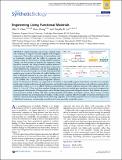Engineering Living Functional Materials
Author(s)
Chen, Allen Y.; Zhong, Chao; Lu, Timothy K
DownloadLu_Engineering living.pdf (878.2Kb)
PUBLISHER_POLICY
Publisher Policy
Article is made available in accordance with the publisher's policy and may be subject to US copyright law. Please refer to the publisher's site for terms of use.
Terms of use
Metadata
Show full item recordAbstract
Natural materials, such as bone, integrate living cells composed of organic molecules together with inorganic components. This enables combinations of functionalities, such as mechanical strength and the ability to regenerate and remodel, which are not present in existing synthetic materials. Taking a cue from nature, we propose that engineered ‘living functional materials’ and ‘living materials synthesis platforms’ that incorporate both living systems and inorganic components could transform the performance and the manufacturing of materials. As a proof-of-concept, we recently demonstrated that synthetic gene circuits in Escherichia coli enabled biofilms to be both a functional material in its own right and a materials-synthesis platform. To demonstrate the former, we engineered E. coli biofilms into a chemical-inducer-responsive electrical switch. To demonstrate the latter, we engineered E. coli biofilms to dynamically organize biotic-abiotic materials across multiple length scales, template gold nanorods, gold nanowires, and metal/semiconductor heterostructures, and synthesize semiconductor nanoparticles (Chen, A. Y. et al. (2014) Synthesis and patterning of tunable multiscale materials with engineered cells. Nat. Mater. 13, 515–523.). Thus, tools from synthetic biology, such as those for artificial gene regulation, can be used to engineer the spatiotemporal characteristics of living systems and to interface living systems with inorganic materials. Such hybrids can possess novel properties enabled by living cells while retaining desirable functionalities of inorganic systems. These systems, as living functional materials and as living materials foundries, would provide a radically different paradigm of materials performance and synthesis–materials possessing multifunctional, self-healing, adaptable, and evolvable properties that are created and organized in a distributed, bottom-up, autonomously assembled, and environmentally sustainable manner.
Date issued
2015-01Department
Massachusetts Institute of Technology. Synthetic Biology Center; Massachusetts Institute of Technology. Institute for Medical Engineering & Science; Harvard University--MIT Division of Health Sciences and Technology; Massachusetts Institute of Technology. Department of Biological Engineering; Massachusetts Institute of Technology. Department of Electrical Engineering and Computer Science; Massachusetts Institute of Technology. Microbiology Graduate ProgramJournal
ACS Synthetic Biology
Publisher
American Chemical Society (ACS)
Citation
Chen, Allen Y., Chao Zhong, and Timothy K. Lu. “Engineering Living Functional Materials.” ACS Synthetic Biology 4, no. 1 (January 16, 2015): 8–11. © 2015 American Chemical Society
Version: Final published version
ISSN
2161-5063